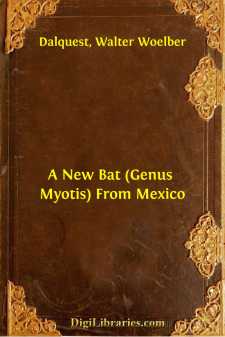Categories
- Antiques & Collectibles 13
- Architecture 36
- Art 48
- Bibles 22
- Biography & Autobiography 813
- Body, Mind & Spirit 142
- Business & Economics 28
- Children's Books 14
- Children's Fiction 11
- Computers 4
- Cooking 94
- Crafts & Hobbies 4
- Drama 346
- Education 46
- Family & Relationships 57
- Fiction 11828
- Games 19
- Gardening 17
- Health & Fitness 34
- History 1377
- House & Home 1
- Humor 147
- Juvenile Fiction 1873
- Juvenile Nonfiction 202
- Language Arts & Disciplines 88
- Law 16
- Literary Collections 686
- Literary Criticism 179
- Mathematics 13
- Medical 41
- Music 40
- Nature 179
- Non-Classifiable 1768
- Performing Arts 7
- Periodicals 1453
- Philosophy 64
- Photography 2
- Poetry 896
- Political Science 203
- Psychology 42
- Reference 154
- Religion 513
- Science 126
- Self-Help 84
- Social Science 81
- Sports & Recreation 34
- Study Aids 3
- Technology & Engineering 59
- Transportation 23
- Travel 463
- True Crime 29
Tadarida femorosacca (Merriam) in Tamaulipas, Mexico
Description:
Excerpt
On January 23, 1946, two pocketed free-tailed bats (Tadarida femorosacca, Catalogue nos. 17852 and 17853) were obtained in a large cave 10 kilometers north-northeast of the village of Antiguo Morelos, in the state of Tamaulipas, Mexico. This extends the known range of this species to the Atlantic Slope and more than 300 miles to the northeast of Zacoalco, Jalisco, the only locality in central Mexico from which the species was previously known (see Shamel, H. H., Proc. U. S. Nat. Mus., vol. 78, art. 19, p. 13, 1931). The total length of the skull (18 mm.) and the basal length (15.0, 15.2) are less than recorded by Shamel (op. cit.) for any one of the eight specimens studied by him. Otherwise our two specimens answer the description of femorosacca. They were found lying on the floor of the cave. One was dead and the other alive but incapable of flight. Shooting into the cracks of the roof of the cave more than a hundred feet high failed to dislodge other bats but stimulated a volume of squeaking of bats which indicated that thousands of individuals, possibly of this species, were ensconsed there. The cave had long been used by bats as attested by the large deposit of guano, much of which had been removed for fertilizer.
Transmitted October 20, 1947....






